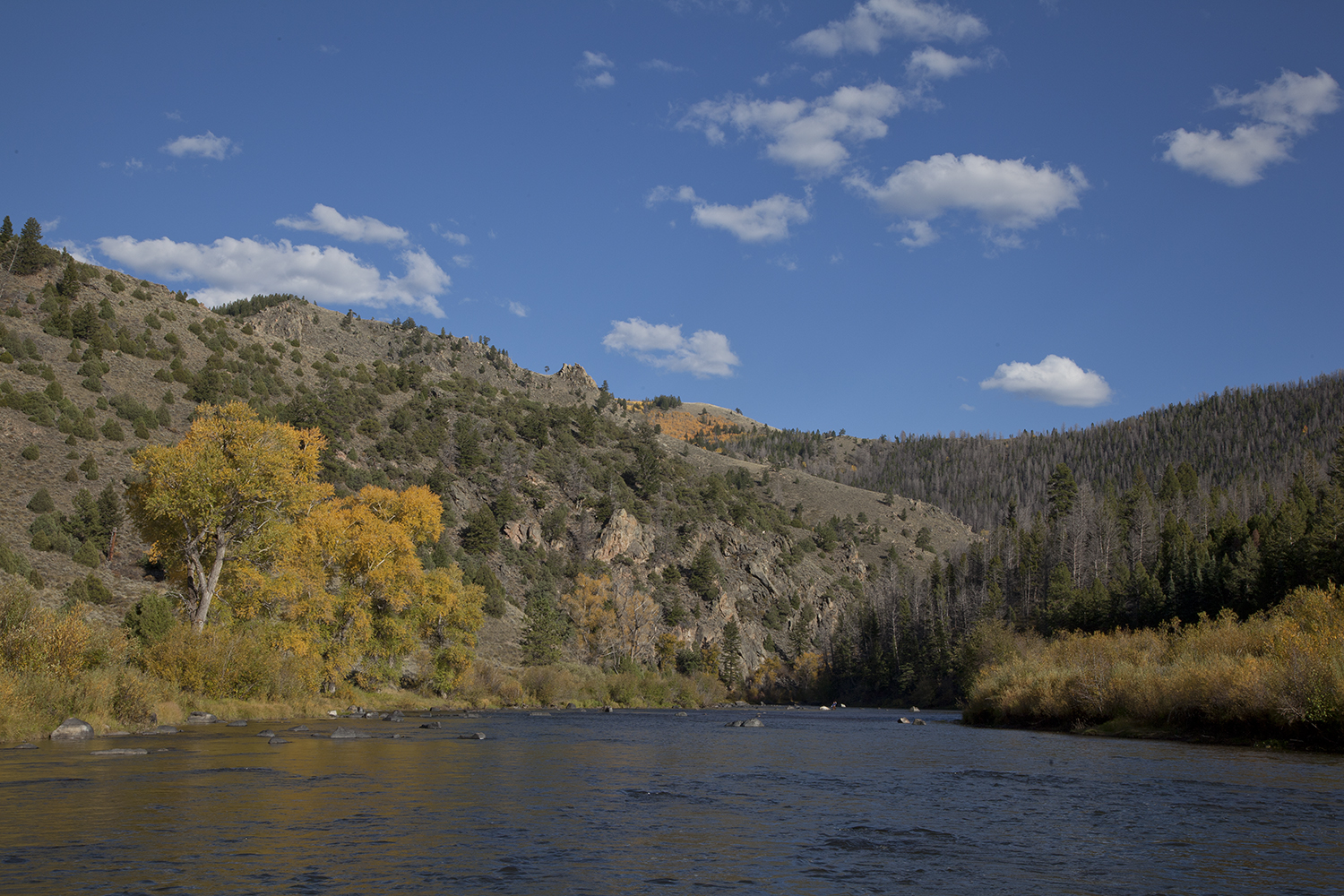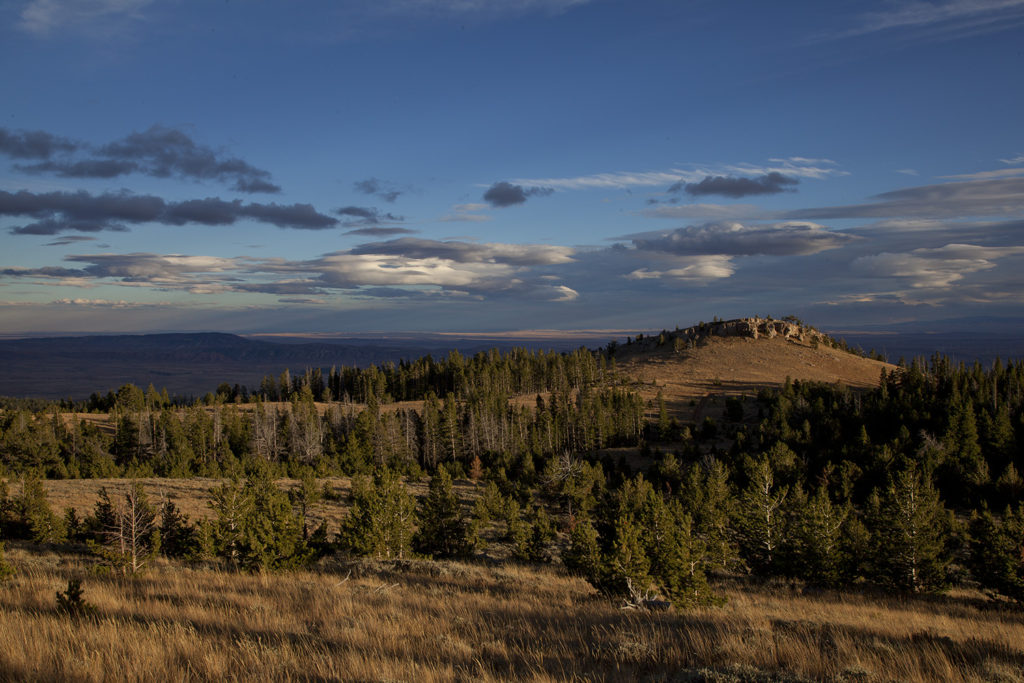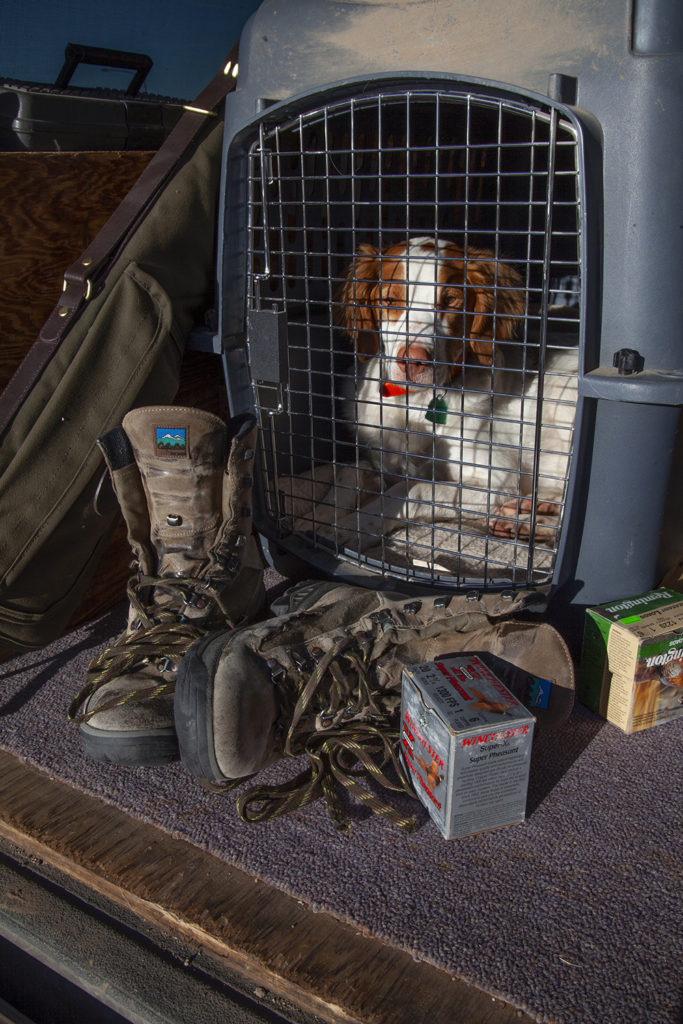
One of my favorite fishing spots, but it’s nearly thirty miles of high-country gravel from the nearest pavement. If I tried getting there in my Prius, I’d leave pieces of the undercarriage scattered over the last fifteen miles of very bad road. (Copyright 2016 by Chris Madson, all rights reserved.)
TREASURE OF THE SIERRA MADRE. ONE OF MY DAD’S FAVORITE FILMS, WHICH MEANT IT WAS BOUND TO BECOME ONE OF MINE. And I guess neither one of us had reason to apologize for that prejudice, since the film won two academy awards in 1948 and has been named one of the fifty best movies of all time.
So many great lines in that film. The one everybody remembers: When Bogart asks the leader of the banditos to show a badge to prove he’s one of the federales he claims to be, the bandito answers, “Badges? We ain’t got no badges! We ain’t got to show you no stinking badges!” One of my favorites always comes to mind when I’m about to start up a mountain after elk: The old prospector looks at the flecks of gold dust in a handful of dirt he’s found at the base of a rockbound ridge and says, “It’s rich, but it’s not that rich. Up there,” pointing to the spine of the mountain, “up there’s where we’ve got to go!” And another of my favorites in elk camp: “Hey, you fellas, how about some beans?” the old prospector asks his two exhausted companions after they’ve collapsed from a hard day’s travel. “Goin’ through some mighty rough country tomorrow,” he says as he loads up his plate. “Better have some beans.” And, when the greenhorns start pouring water on a rock they think is the motherlode, the old prospector tells them it’s just pyrite. “Say, next time you two fellas strike it rich, holler for me before you start splashing water around. Water’s precious— sometimes, more precious than gold.”
One other line has drifted to mind in the last few weeks. Humphrey Bogart draws a pistol on his partner as they make camp for the night, forces him out into the darkness at gunpoint, and shoots him for the gold the two of them have spent the better part of a year digging out of solid rock. He comes back to the campfire, struggling to come to terms with what he’s done.
“Conscience,” he says to himself, as he stares into the flames. “What a thing. If you believe you’ve got a conscience, it’ll pester you to death. But, if you don’t believe you’ve got one, what can it do to you?”
Here, in the first warm days of spring, that line comes back to me.
I live in Cheyenne, Wyoming. If you draw a circle 200 miles in radius around the town, you’ll find a ready supply of just about everything that feeds my soul:
Some of the most famous trout water in America and a dozen other streams that are almost as good and practically unknown.
The sagebrush grasslands of the big sky country, last refuge of something like three-quarters of all the pronghorn left on planet Earth, home to mule deer and desert elk, sage grouse and golden eagles, bobcats and swift foxes.

The pursuit of elk in the high West leads to some exceptional places at exceptional moments. This one is twenty of the worst miles in creation from the nearest highway. (Photo by Chris Madson, copyright 2018, all rights reserved).
The high country— lodgepole and aspen up into the spruce and fir, and, finally, the tundra where the willows cling to lichen-spangled boulders around the high lakes and the brook trout fight each other to take a fly. Elk, moose, bighorn sheep.
The marshes where mallards and geese congregate in the fall and the prairies to the east, where the sharptails and pheasants wait to match wits with my Brittanies.
These are the places and things that have sustained me, lo these fifty years and more.
Draw a twenty-mile circle around Cheyenne and you will find none of them.
For nearly all my adult life, the days I’ve treasured always begin with a drive of forty, eighty, sometimes as much as 250 miles, one way. And they generally end on a sketchy Forest Service road covered with busted rock and blocked by the occasional fallen tree, a dirt track rim-deep in mud, a section road covered by two feet of wind-driven snow, or a tractor trace along the edge of a field of CRP where the badger holes are mostly camouflaged by little bluestem and switchgrass and the snowdrifts are never disturbed by the county plows.
For all those reasons, my main outdoor transport has long been a four-wheel-drive pickup. Real four-wheel, not the all-wheel drive that sells low-slung compact SUVs to the suburban set. A lot of the time, I need high clearance to get over loose rock or deep ruts, and, now and then, I need serious low-range four-wheel drive. I don’t need it very often, but when I do, I really, really need it. Often with chains on all four wheels. And a shovel. I may be eighty miles from the nearest tow truck; thirty or forty nasty, suspension-pounding miles from the nearest house or pavement; twenty miles (in an unknown direction) from the nearest guy with a pick-up who might consent to help me. Out of cell range. In circumstances like those, grandma gear in all four comes to the rescue.
The obvious disadvantage of this transportation is the gas it consumes. I wince when I fill the tank on my way out of town . . . and fill it again when I get back. It’s a bite in the billfold, but for many years, I’ve comforted myself with two justifications for the expense: first, that these trips stock the family freezer with our annual supply of red meat and poultry, the domestic versions of which don’t come cheap, and second, that I’d probably spend just as much or more if I took up golf or started spending Saturday nights at the sportsbar. This is probably nothing more than transparent rationalization on my part, but it has helped soothe my misgivings about the cost.
Harder to soothe are my misgivings about what I leave behind as I drive down the road. The carbon dioxide.
I began to pay close attention to the threat of climate change quite a while back, and, as the years have passed, my concern has deepened steadily. In the 1990s, my region of the country went through a drought that lasted, almost without relief, for nearly a decade, and the federal drought monitors in the last few months suggest that we may be on the front end of another one just like it. Hardly a summer goes by when there isn’t a week or two of smoke hanging over town, the sun a pale white orb in a noonday sky whose color has faded from blue to dirty tan as another forest goes up in flames. Researchers are finding that mule deer in my part of the world regularly suffer from poor nutrition on their summer range— it’s hard to grow rich browse when there’s no rain. By the middle of July, some of my favorite trout streams have dwindled to pathetic trickles, too small and too warm to fish. Last October, I loaded my decoys and headed to my favorite duck marsh, only to find an expanse of cracked mud when I arrived. My favorite pheasant and sharptail haunts were strangely short of birds last fall, probably because of a series of severe thunderstorms that swept the area with cold rain and hail just as the nests hatched.
Climate change has touched me where I live, literally and metaphorically. It’s eating away at the wildlife and wild places that keep me sane and grounded in a world that otherwise seems to make little sense. It makes me so angry I can’t breathe, and then the anger turns to sadness, the sadness to regret, the regret to guilt. Because I’ve played a part in what is happening. I still play a part. . . .

Bird dogs take space and a lot of equipment, more easily carried in a pickup than a Prius. One of the last times the dogs and I were out in search of pheasants last January, we got stuck in a snow drift— even with high clearance and four-wheel drive. Luckily, I had a shovel in back . . . and tire chains. (Photo by Chris Madson, 2019, all rights reserved)..
We’ve tried to minimize our impact, my wife and I. We live on a postage stamp lot in an aging suburb because we recognize that our impact would be far greater if we had settled on a ten-acre lot at the edge of a national forest in the middle of crucial big game winter range. We let the bluegrass lawn die when we moved in, and we xeriscaped to save a little more water for the trout. We’ve insulated, replaced windows, invested in a high-efficiency furnace and high-efficiency appliances as the old ones have worn out. For much of my office career, I commuted to work on my bike for nine or ten months out of the year. Our over-the-road vehicle is a Prius we couldn’t afford, and when Kathy retired a few years back, she decided to spend her retirement check on eighteen solar panels instead of replacing our dilapidated fifty-year-old kitchen. I’ve completely surrendered the notion of fishing with friends in Alaska or Baja or the far-flung waters of Argentina, and I haven’t flown anywhere in almost a decade. We even think twice before we plan a road trip to see relatives.
Some of the choices we’ve made have been relatively easy and inexpensive, but the easy ones— like the LED light bulbs and weatherstripping around the doors— have long since been checked off the list of things we could do to help. The ones that remain have become ever more difficult and often more than our income could really support. Our growing sense of emergency has forced us to keep nibbling away at the list because our carbon footprint, while much less than the average American’s, is still huge. As I watch the things I treasure slowly, almost imperceptibly, slipping away, the question arises: What more can I do?
The price tags on those remaining decisions are pretty steep: stand-alone solar panels, battery storage for the electricity so we could maybe go completely off-grid, another round of even more efficient windows, electric furnace, electric on-demand water heater. We’ll chip away at those as we find the cash, neglecting the worn-out carpets and sagging kitchen cabinets.
And I’ll see if I can find a compromise between clearance and all-wheel drive on one hand and gas efficiency on the other. Fully electric transport is still not practical on the wild landscapes I frequent— the range of electric vehicles is too limited; charging stations are far too scarce, and charging times simply too long. If I win the lottery, I may look into a hybrid SUV, but, the price tags are breathtaking, and, in the long term, even that compromise won’t be sufficient. General Motors has committed to producing nothing but electric vehicles by the year 2035. If they reach that goal or come anywhere close, I wonder how many gas stations will be left, especially on the unpopulated landscapes of the High Plains and Intermountain West.
Some sort of carbon tax also looms on the horizon, enthusiastically supported by many climate activists. It seems like a fairly straightforward way of using market forces to wean people off gasoline engines, and people of means in urban areas might find the transition to new transportation relatively easy. For me, out here in the Big Empty, it may well mean the end of a way of life. I fully recognize that the continued deterioration in climate will have the same effect, and so I’m caught between a large rock and a very hard place.
As difficult as this is to admit, the ethical choice may well be for me to abandon that way of life. Sell the pickup truck before it becomes unmarketable, the backpacks and mountain tents, the spinning rods and fly rods, the duck and goose decoys, the canoes, the shotguns and centerfire rifles, the high-energy Brittanies. Settle down to some backyard birdwatching and a seasonal appreciation of the wildflowers that decorate the battered prairie behind the local big box store. Become a “townie” in every sense of the word.
I’m ready to make that sacrifice, even though I bleed at the thought. But here’s the thing: I’m NOT ready to sacrifice so much that I hold dear until America shows its willingness to do something similar. Something more than turning down the thermostat. I’ve taken many steps to reduce my carbon footprint. I’ve sacrificed conveniences and luxuries to pay for the things we’ve done to reduce our impact. As I watch the bustle along the Front Range, I see folks who are trying. They’re biking instead of driving; they’re investing in hybrids and solar panels. But for every one of those committed people, there are thousands who just don’t seem to give a damn. Before I give up the things I love most, I have to see some evidence that most other people are willing to do what’s required.
This is all just another round of rationalization, of course. Here I am, across the fire from Bogart, reflecting on conscience, responsibility, and ethical dilemmas. I won’t abandon the dictates of conscience but neither am I inclined to take the clear path to some sort of ethical purity all by myself. We got into this mess together; we’ll have to get out the same way. And that will mean sacrifice. From everyone.
—————
Leave a Reply
You must be logged in to post a comment.